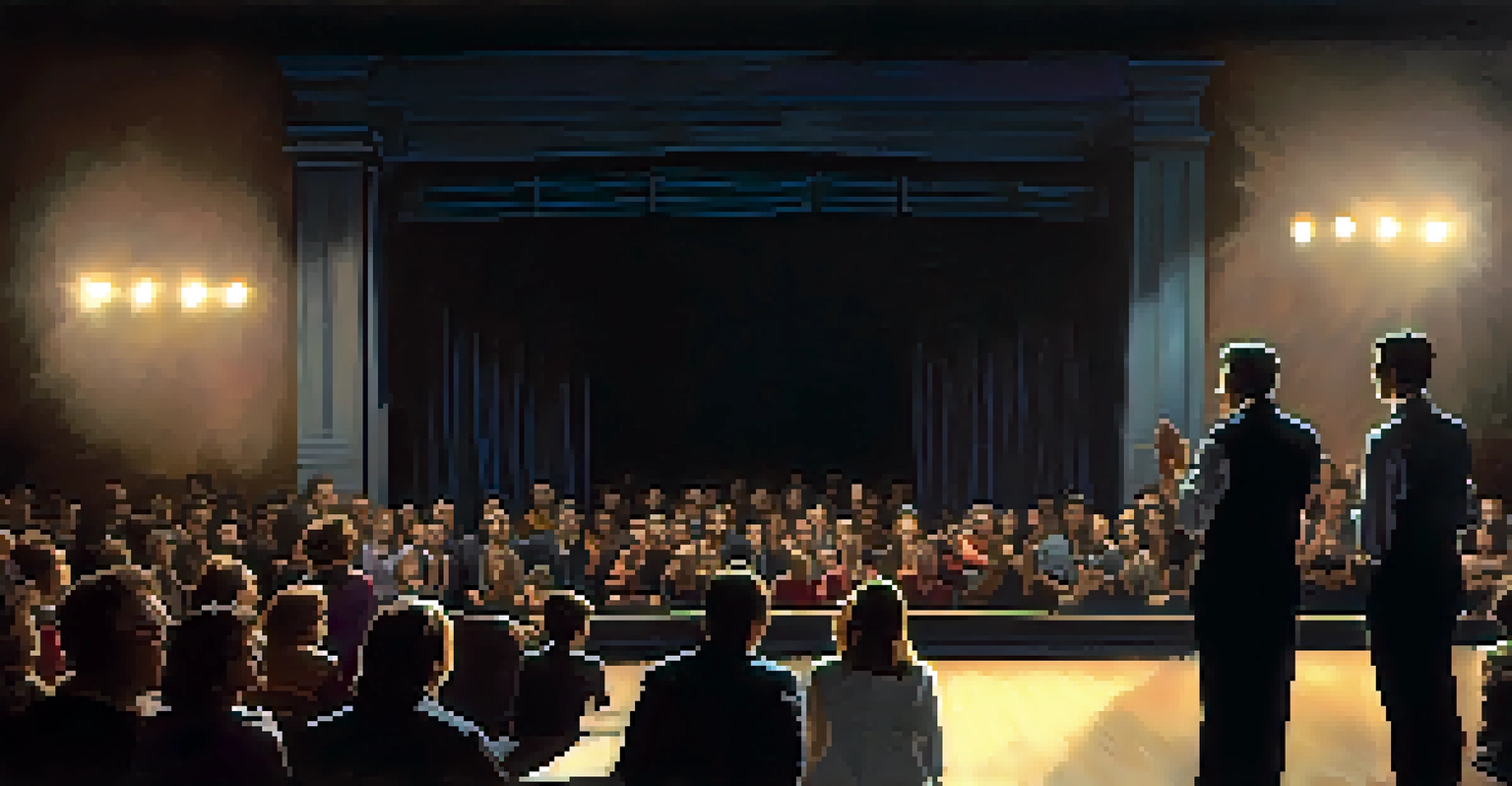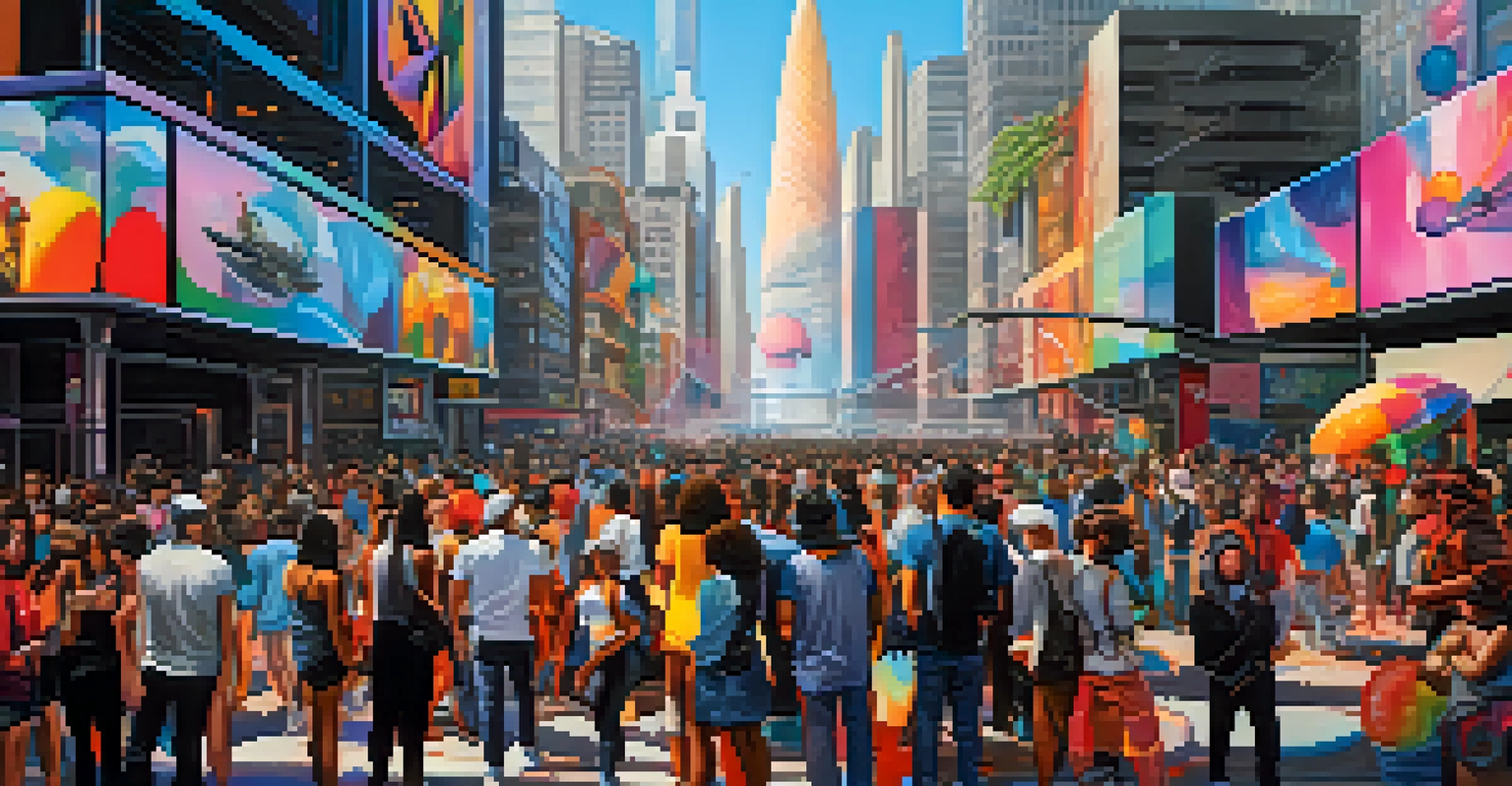Art as a Tool for Social Change: Case Studies and Impact

Understanding Art's Role in Social Movements
Art has always been a powerful medium for expressing ideas and emotions, often reflecting societal issues. By serving as a voice for the marginalized, art can inspire action and provoke thought. It connects people on a personal level, making complex social issues more relatable and igniting passion for change.
Art is not a mirror held up to reality, but a hammer with which to shape it.
From murals to performances, the various forms of art provide platforms for dialogue and awareness. They engage audiences in ways that statistics or reports may not, pulling them into the narrative of the oppressed. This emotional engagement often leads to increased empathy and a desire to take action.
Related Resource
As we explore case studies, we will see how artists have utilized their craft not just to entertain, but to challenge the status quo and advocate for justice. By blending creativity with activism, art becomes a vital tool in the fight for social change.
Case Study: The Impact of Street Art in Urban Communities
Street art is a vibrant example of how public spaces can be transformed into platforms for social commentary. Artists like Banksy have utilized urban walls to highlight issues such as war, poverty, and consumerism, often sparking conversations within the community. These visually striking pieces reach a wide audience, transcending language barriers and socioeconomic divides.

In cities like São Paulo, Brazil, street art has been instrumental in reclaiming neighborhoods and instigating social change. Local artists have created murals that celebrate culture while addressing local issues such as violence and inequality. This not only beautifies the area but fosters a sense of pride and ownership among residents.
Art as a Catalyst for Change
Art serves as a powerful medium that inspires activism and fosters awareness of social issues.
As street art gains recognition, it challenges the perception of public spaces and encourages local governments to engage with the community. By acknowledging and supporting these artists, cities can create inclusive environments that reflect the voices and stories of their inhabitants.
The Power of Theatre in Advocacy and Awareness
Theatre has long served as a powerful medium for social change, combining storytelling with performance to evoke emotions and provoke thought. Productions like 'The Vagina Monologues' have sparked global discussions on women's rights and sexual violence. Through compelling narratives, theatre brings personal stories to the forefront, making issues more accessible and relatable.
The artist is not a special kind of person; rather, each person is a special kind of artist.
In community settings, theatre can empower individuals to share their experiences and engage in critical dialogue. Programs like Theatre of the Oppressed encourage participants to explore social issues through improvisation and role-playing, allowing them to envision and enact change. This interactive approach fosters a sense of agency among community members.
Related Resource
By using the stage as a platform for advocacy, theatre companies can create a ripple effect that extends beyond the performance. Audiences leave with a deeper understanding of societal issues, often motivated to engage in activism or support local initiatives that align with the themes explored in the production.
Music as a Vehicle for Social Justice Movements
Music has the unique ability to resonate with people on an emotional level, making it an effective tool for social change. Songs like 'Fight the Power' by Public Enemy have become anthems for movements advocating for racial equality and justice. The infectious nature of music encourages collective action and creates a sense of solidarity among listeners.
Throughout history, musicians have used their platforms to raise awareness about pressing social issues. From Bob Dylan's protest songs during the Civil Rights Movement to contemporary artists like Kendrick Lamar addressing systemic racism, music continues to play a crucial role in shaping public discourse. These artists often inspire their audiences to take action through rallies, petitions, or community organizing.
Street Art Transforms Communities
Street art not only beautifies urban spaces but also sparks vital conversations about social justice and local identity.
By intertwining messages of social justice with catchy melodies, musicians can reach diverse audiences and inspire them to engage in meaningful change. This powerful combination of art and activism helps to create a culture of awareness and advocacy that can lead to tangible impacts in society.
Photography's Role in Documenting Social Change
Photography has the power to capture raw emotions and moments in time, making it a pivotal medium for social change. Photographers like Dorothea Lange documented the struggles of the Great Depression, evoking empathy and prompting policy changes. The visual impact of these images often leads to a deeper understanding of societal issues.
In the modern era, social media platforms have amplified the reach of powerful photographs, allowing them to go viral and spark global movements. The #BlackLivesMatter movement, for instance, gained momentum through impactful images that brought attention to systemic racism and police violence. These visuals inspire solidarity and action across borders.
Related Resource
By documenting social issues through their lens, photographers can create a historical record that fosters dialogue and encourages accountability. Their work serves not only to inform but also to inspire future generations to continue the fight for justice and equality.
Dance as a Form of Protest and Expression
Dance is often viewed as a form of entertainment, but it can also be a profound means of protest and expression. Choreographers like Bill T. Jones have used dance to address themes of identity, race, and social justice, creating performances that challenge audiences to confront uncomfortable truths. The physicality of dance allows for a visceral connection to these issues, often leaving a lasting impact.
In addition to traditional stages, dance has taken to the streets as a form of public protest. Events like the Dance Parade in New York City celebrate diversity while advocating for social justice. These gatherings not only showcase talent but also unite communities around shared values, promoting inclusion and acceptance.
Digital Art Amplifies Activism
In the digital age, artists leverage online platforms to engage diverse audiences and advocate for pressing social causes.
Through movement, dancers can communicate messages that transcend words, fostering a deeper understanding of social issues. This art form invites audiences to engage with complex topics in an approachable manner, inspiring them to reflect on their own roles in the quest for social change.
Digital Art and Its Role in Modern Activism
In our increasingly digital world, art has found new platforms for expression and activism. Digital artists use social media, websites, and virtual reality to create immersive experiences that challenge societal norms and advocate for change. This innovative approach allows for a broader reach, engaging audiences who may not traditionally interact with art.
Campaigns like #ArtForChange leverage digital art to raise awareness about social issues, from climate change to human rights. By creating visually striking content that resonates with online communities, artists can inspire action and mobilize support for various causes. The shareability of digital art amplifies its impact, making it an effective tool for modern activism.

As technology continues to evolve, artists are finding new ways to push boundaries and create conversations around crucial topics. By embracing digital mediums, they can connect with diverse audiences, fostering a sense of community and collaboration in the pursuit of social justice.
Conclusion: The Lasting Impact of Art on Society
Art remains an essential and dynamic tool for social change, inspiring movements and creating communities. Through various mediums, artists challenge perceptions, foster empathy, and provoke action, all while highlighting the stories of those often unheard. The case studies we've explored demonstrate the profound impact art can have on societal issues.
As we reflect on the power of art, it's essential to recognize that everyone can play a role in this transformative process. Whether through creating, sharing, or engaging with art, individuals can contribute to a culture of awareness and advocacy. This collective effort can help shape a more just and equitable society.
Ultimately, the intersection of art and social change reveals the potential for creativity to inspire action and create lasting impact. As we continue to champion these efforts, we pave the way for a future where art remains a vital catalyst for positive change.